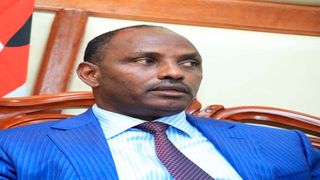
National Treasury and Planning Cabinet Secretary Ukur Yatani during an interview at his office on February 10, 2021.
| Jeff Angote | Nation Media GroupBusiness
Premium
World Bank and IMF open taps for Kenya
The Covid-19 pandemic has seen the World Bank and the International Monetary Fund (IMF) release their lending purse strings for Kenya in a trend that has seen Kenya net nearly Sh500 billion in a year.
The two Bretton Woods institutions have been announcing one loan approval after another in quick succession at a time when the National Treasury is faced with a serious cash crisis.
The latest loan came on Tuesday when the World Bank board revealed that it had approved an additional Sh14 billion ($130 million) to enable Kenya procure more vaccines via the African Vaccine Acquisition Task Team (AVATT) initiative and the Covid-19 Vaccines Global Access (Covax) facilities.
It will also support the deployment of those vaccines by boosting Kenya’s cold chain storage capacity-including establishing 25 county vaccine stores, strengthening the capacity of 36 sub-county stores, and equipping 1,177 health facilities with vaccine storage equipment.
“This additional financing comes at a critical time when the Government of Kenya is making concerted efforts to contain the rising cases of Covid-19 infections and accelerate the deployment of vaccines to a wider population,” said Keith Hansen, World Bank Country Director for Kenya.
“The upfront financing for the acquisition of Covid-19 vaccines will enable the government to expand access to more Kenyans free of cost.”
Others financing
This is the second additional financing for the Kenya Covid-19 Health Emergency Response Project.
Together with the Sh1 billion ($10 million) triggered under the Contingency Emergency Response Component of the Transforming Health Systems for Universal Care Project, the World Bank’s contributions to Kenya’s Covid-19 response now stands at Sh26.3 billion ($246 million).
Earlier this month, on June 10 2021, the World Bank approved another Sh80 billion ($750 million) loan through the Development Policy Operation (DPO). The lender said the billions will be used to reinforce Kenya’s resilient, inclusive and green economic recovery from the Covid-19 crisis.
DPOs are used by the World Bank to support a country’s policy and institutional reform agenda to help to accelerate inclusive growth and poverty reduction.
The lender said the money from the development policy financing would support policy reforms that will strengthen transparency and accountability in public procurement and promote efficient public investment spending.
In April 2021, the International Monetary Fund (IMF) signed Sh257Bn (US$2.4 billion) loan for Kenya to be disbursed over a 38-month programme under the Extended Credit Facility (ECF) and Extended Fund Facility (EFF). Already Kenya has received a total of Sh78 billion from this in two tranches of Sh44 billion ($410 million) in May and Sh34.45 billion ($314 million) in April.
The multilateral lender said it is satisfied with the ongoing reforms Kenya committed to implementing as part of its funding conditions that allowed it to approve a second disbursement.
Increased borrowing
The IMF conducted its first review of the financing programme led by Ms Mary Goodman through a virtual mission from April 29 to May 14, 2021.
The remaining part of the loan is expected to be disbursed every six months after IMF reviews.
In May last year, the World Bank again approved another Sh107 billion ($1 billion) budget support operation for Kenya.
The money was to help Kenya close the fiscal financing gap, while supporting reforms that help advance the government’s inclusive growth agenda, including in affordable housing and support to farmers’ incomes.
As soon as Covid-19 hit Nairobi last year, Kenya stepped on the borrowing gas pedal hard, reaching out to multilateral lenders in a bid to build its war chest in the fight against the Covid-19 pandemic.
The World Bank was the first to open its purse strings, extending an immediate Sh6.8 billion support to the Health ministry for preparations and response, as it retreated to consider a bigger loan.
Then its Bretton Wood sibling, the IMF came in second advancing Nairobi with Sh78.3 billion to deal with the pandemic. At the time, Kenya said it was expecting a major cash shortage due to the containment measures.
After IMF disbursement, the World Bank wired another Sh108 billion to the Central Bank of Kenya (CBK), as both budgetary support and extra resources to help fight the deadly viral infection.
That was not all. The African Development Bank also joined the fundraising effort, sending Nairobi an extra Sh22.5 billion boost as concessional loan. The European Union topped this up with an additional Sh7.5 billion in form of grants.
In just under 60 days of the pandemic, Kenya had already secured Sh223 billion as part of its Covid-19 war chest.
This was before it launched other fundraising efforts from the commercial lenders at both local and international markets. It did not stop there, it also went out, seeking debt relief from the big lenders.
Credit worthiness
Though IMF loans come cheap and are seen in international capital markets as an endorsement of the credit worthiness of a country, this latest loan from the IMF elicited opposition from Kenyans online who signed a petition asking IMF to stop loaning the country due to misuse of previous funds. Over 235,000 Kenyans had signed the petition.
The loan also comes with structural reforms that are expected to tough on parastatals and various government agencies.
The parastatals lined up for structural reforms include Kenya Airways, Kenya Airports Authority (KAA), Kenya Railways Corporation (KRC) and Kenya Power.
Others are Kenya Electricity Generating Company, Kenya Ports Authority and the three largest public universities – Nairobi, Kenyatta and Moi – among those to be reformed.





